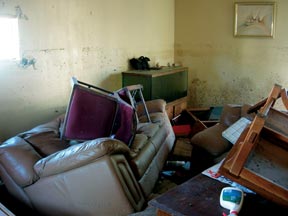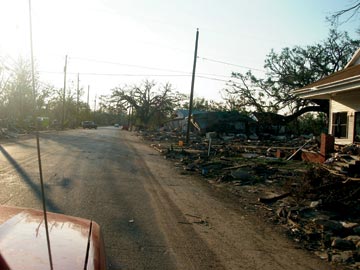Biloxi, Katrina and Three Young Laurentians
Last fall, three
recent graduates, all English majors, made their way to
the Gulf Coast to join the Hurricane Katrina relief effort.
Bethany Taylor ’04,
Josh Potter ’05
and Laura Woltag ’05
worked with Hands on USA (HOUSA), a non-profit, volunteer-based
relief organization. Originally
conceived in post-tsunami Thailand, HOUSA has been on site
in Biloxi since a few days after the hurricane hit. Conducting
its recruitment almost exclusively by way of the Internet
and word of mouth, the organization has succeeded in providing
an international hub for transient volunteers, free of
the red tape and bureaucracy that have hung up many of
the larger-scale operations along the coast. Their
reflections on their experiences follow:
Bethany Taylor:
 |
The Tools of Their Trade: From left, Bethany Taylor,
Josh Potter and Laura Woltag prepare for another day of
relief work in Biloxi, Miss., following Hurricane Katrina.
Their t-shirts provide the name of the agency under whose
auspices they volunteered. |
I had heard the phrase “hurricane-ravaged area” tossed around
like Mardi Gras beads. I had seen the pictures of destruction. I
figured to head South and see what I could do to help. I had
no preparation; I felt it was unnecessary. On the St. Lawrence Kenya program
I’d
slept in a cardboard house in the Nairobi slums, and thought
that I was impervious to shock when it came to living situations.
I was wrong. This was an entirely different world, made all the stranger
by the fact that it was in the same country I live in.
My first
image was of mountains of debris outside all the houses. Everything
from family photos and kitchen utensils to sheetrock and flooring had to
be removed, so pernicious was the mold. East Biloxi is a long peninsula
sticking eastward into the Gulf; the hurricane hit from the south, from
the ocean, and crashed through the city. Then the storm surge swelled on
the three waterbound sides of Biloxi.
One gentleman
I spoke with was, three months after the hurricane, unable
to sleep; every time he shut his eyes he saw a 40-foot wall
of water. That was the storm surge, the cause of the mold problems. Houses
stood seven and eight feet under water, which, as it receded, left so much
mud and moisture that mold flourished in the heat and humidity. HOUSA worked
to gut the houses down to the studs, and left huge mounds, formerly loved
possessions, in the streets. Few things could be saved; the
mud and mold were deemed health hazards. Teddy bears and shoes lying moldy
and dusty in the streets came closest to breaking my heart.
A few days
of shock at this, and then came the blessed dulling of thoughts and
emotions. It was normal to see houses off foundations, normal to maneuver
around piles of debris in the streets. I worked with Barb Stagg, a nurse
volunteering from West Virginia, giving tetanus and hepatitis A vaccines
to all who would take them. But more than giving shots or taking blood
pressure or checking blood sugar, we did the most good by simply listening
as person after person poured out their stories.
Laura Woltag:
The core relief services provided by HOUSA included gutting
houses, mold remediation, tree removal, supply distribution and medical
teams. These groups dispersed regularly each morning, working
the streets of East Biloxi until the sun set over floating chunks of
I-90 and beached casino barges.
The beauty of HOUSA is that it encourages volunteers to seek
individual and unique needs in the community. When I learned there
were no arts classes in the public elementary schools I collaborated
with visual artist and fellow volunteer Genessee Klem to teach arts expression
classes in four schools. With the help of some grant money and the
full support of HOUSA, we were able to work with over 500 kids.
Genna
and I were touched by the work we saw. Many children drew “before
and after” pictures of their houses, including their renditions of
the infamous X’s spray-painted on every front door. These markings
indicated if the structure was secure, how many people were
found dead, the date of inspection, and more. We also discovered the universal
symbol for the hurricane—black scribble.
While the students drew they told stories. One little boy was shoved
up his chimney; another girl rode out the storm on her family’s shrimp
boat; several children were tied to trees or clung to rooftops.
While volunteering at HOUSA I became interested in volunteer
coordination issues and Biloxi City Council politics. The majority of my final
weeks were spent trying to coordinate with other relief groups to facilitate
the formation of a homeless shelter. I was inspired to pursue this
project after discovering evidence that people were sleeping in porta-potties
outside of the Salvation Army distribution center. There is still
a real need for short-term shelter for those still sleeping in the cold
of their mold-infested homes, squatting in gutted houses, finding refuge
in urinals.
The motto at HOUSA is “find a project and go.” It creates an
environment that’s the most inspiring place I’ve ever lived,
worked and learned. Evident here is the power of networking resources. Amidst
the tragic impoverishment of this community there is brilliant confidence
that anything is possible.
 Josh Potter:
Josh Potter:
For me, the most difficult task Hurricane Katrina dealt was
to explain to my family and friends exactly why the best thing
for me to do upon graduation was to travel clear across the country and immerse
myself in a potentially hazardous environment where I knew virtually no one,
in exchange for only two square meals a day and a roof over my head. Somehow,
though, it seemed unequivocally right. The support was overwhelming,
yet I found myself resorting to generational justifications. This
is my generation’s great calling, I’d say (to myself more
than anyone else). Whereas most nations would require social
or military service of a person my age, this is a chance to
join a legion of do-gooders driven more by interest and willingness than
conscription or financial necessity.
When at
last I found myself with a crowbar in my hand and a Tyvek jumpsuit on my back,
the rest was just sweat and tears. We were volunteers, and that seemed
to make all the difference. In very little time it was HOUSA, a motley
crew of seasonal transients, pro-bono contractors, vacation-time consolidators
and wayward post-grads, that developed the reputation as the ones to “get
it done” in the community, more so than FEMA or the Salvation Army. Arrival
was justification enough for a volunteer’s being there; despite the diversity
of stories and hometowns, we’d all found ourselves in Biloxi.
We’d
joke about HOUSA headquarters as a type of “hurricane camp” where
age, race and region fell away under to a work-hard-play-hard mentality that
kept things running with amazing efficiency. In light of the shortcomings
national disaster-response organizations showed, it seemed astounding that
something as simple and effective as HOUSA had not been utilized in the past
or to such great effect. The only thing I can remotely compare the experience
to is St. Lawrence’s Adirondack Semester, in which the willingness and
interest of the participants are necessary to the success of the program. Only
with HOUSA, the stakes were a rung or two higher.
 Looking
back, I have trouble sorting out whose story will leave a greater imprint on
my memory--the elderly woman who floated to safety on her closet door, or the
Colorado opera singer who rode 2,000 miles on her motorcycle to help.
Looking
back, I have trouble sorting out whose story will leave a greater imprint on
my memory--the elderly woman who floated to safety on her closet door, or the
Colorado opera singer who rode 2,000 miles on her motorcycle to help.
East
Biloxi did not receive the same national attention as other Gulf Coast cities
like New Orleans. But thanks
to the concentrated community efforts made by HOUSA, it is slowly getting back
on its feet. Amidst crowbar thrashing, tetanus immunizations and Re-Jubilation
days, the Deep South grew on us in a way no one expected. The sunsets,
catfish po-boys and “God bless y’all’s work,” became
as familiar as the sight of endless rubble, the stench of two-month-old standing
water, and the battered golden arches of McDonald’s. East Biloxi became
our home. Both the residents returning to their devastated communities
and the three of us shifting back into our non-hurricane realities resonate
with Bob Dylan, as he belts out in Mississippi, “the emptiness
is endless / cold as the clay / you can always come back / but you can’t
come back all the way.”



 Josh Potter:
Josh Potter: Looking
back, I have trouble sorting out whose story will leave a greater imprint on
my memory--the elderly woman who floated to safety on her closet door, or the
Colorado opera singer who rode 2,000 miles on her motorcycle to help.
Looking
back, I have trouble sorting out whose story will leave a greater imprint on
my memory--the elderly woman who floated to safety on her closet door, or the
Colorado opera singer who rode 2,000 miles on her motorcycle to help.